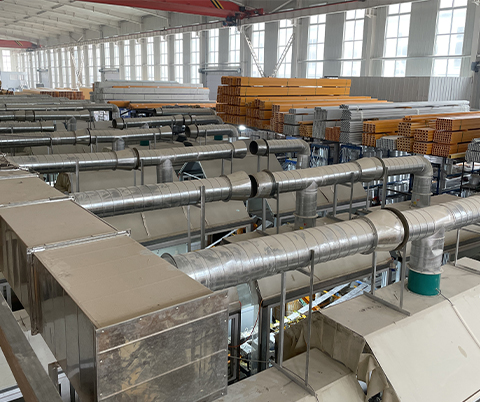loading...
- No. 9, Xingyuan South Street, Dongwaihuan Road, Zaoqiang County, Hengshui, Hebei, China
- admin@zjcomposites.com
- +86 15097380338
- Welcome to visit our website!
frp pressure tank
Understanding FRP Pressure Tanks A Comprehensive Overview
FRP (Fiberglass Reinforced Plastic) pressure tanks are engineered containers designed to hold gases or liquids at a pressure significantly higher than atmospheric pressure. These tanks are widely used in various industrial applications, including water treatment, chemical processing, and oil and gas industries, due to their superior strength, durability, and resistance to corrosion.
What are FRP Pressure Tanks?
FRP pressure tanks are constructed using a composite material that combines fiberglass fibers with a polymer matrix. This unique combination results in a lightweight yet incredibly strong material capable of withstanding extreme pressures. The manufacturing process involves the layering of fiberglass, which is then cured, usually in a high-temperature environment to enhance its structural integrity.
One of the primary advantages of FRP pressure tanks is their ability to resist corrosion, which is a significant issue in many traditional metals. This makes them ideal for storing aggressive chemicals, brine solutions, and other corrosive substances. Moreover, FRP tanks do not rust or degrade over time as metal tanks do, ensuring longevity and reliability.
Applications of FRP Pressure Tanks
FRP pressure tanks are versatile and can be found in a myriad of applications. In the water treatment industry, for example, these tanks are commonly used for storing and treating large volumes of water, facilitating processes such as filtration and chemical dosing. Their resistance to corrosion ensures that the treated water remains uncontaminated.
In the oil and gas sector, FRP pressure tanks are utilized for the storage of hydrocarbons and other chemicals. The lightweight nature of the tanks allows for easier transportation and installation, while their durability ensures safe storage under high pressure. Additionally, experience has shown that these tanks can withstand extreme environmental conditions, making them suitable for various geographical locations.
The chemical manufacturing industry also benefits from the use of FRP pressure tanks. These tanks can store raw materials or finished products without the risk of contamination from rust or corrosion. Moreover, the adaptability of FRP materials allows for customization in tank shape and size, tailored to meet specific needs of chemical processes.
Advantages of FRP Pressure Tanks
The benefits of using FRP pressure tanks are numerous
frp pressure tank

1. Corrosion Resistance One of the most significant advantages of FRP tanks is their ability to resist corrosion from various chemicals and the environmental factors that can degrade traditional materials.
2. Lightweight Compared to metal tanks, FRP tanks are much lighter, making transportation and installation more manageable. This characteristic can lead to lower overall project costs.
3. High Strength-to-Weight Ratio FRP tanks offer a high strength-to-weight ratio, which means they can withstand high pressures while remaining lightweight.
4. Thermal Insulation FRP provides excellent insulation against temperature extremes, making these tanks suitable for applications where temperature control is essential.
5. Cost-Effectiveness Although the initial cost of FRP tanks can be higher than that of traditional materials, their longevity, low maintenance needs, and operational safety often result in lower overall lifecycle costs.
Maintenance and Safety Considerations
While FRP pressure tanks are durable, regular maintenance is essential to ensure their longevity and safe operation. Inspections should include checking for any signs of damage, such as cracks or delaminations. Proper installation is also critical to prevent accidental damage and ensure the tanks function correctly under pressure.
Safety is paramount when dealing with pressure tanks. Operators must adhere to industry regulations and guidelines, including those related to the maximum allowable working pressure (MAWP) and safety relief systems. Training and understanding the properties of the materials involved are crucial for personnel working with FRP pressure tanks.
Conclusion
In conclusion, FRP pressure tanks are an innovative solution to various industrial storage challenges, offering resilience, durability, and efficiency. Their applications across diverse sectors highlight their importance in modern engineering and manufacturing. As industries continue to evolve, the demand for such advanced materials will likely increase, ensuring that FRP pressure tanks remain a vital component of safe and effective operations.
-
The Rise of FRP Profiles: Strong, Lightweight, and Built to LastNewsJul.14,2025
-
SMC Panel Tanks: A Modern Water Storage Solution for All EnvironmentsNewsJul.14,2025
-
GRP Grating: A Modern Solution for Safe and Durable Access SystemsNewsJul.14,2025
-
Galvanized Steel Water Tanks: Durable, Reliable, and Ready for UseNewsJul.14,2025
-
FRP Mini Mesh Grating: The Safer, Smarter Flooring SolutionNewsJul.14,2025
-
Exploring FRP Vessels: Durable Solutions for Modern Fluid HandlingNewsJul.14,2025
-
GRP Structures: The Future of Lightweight, High-Performance EngineeringNewsJun.20,2025
